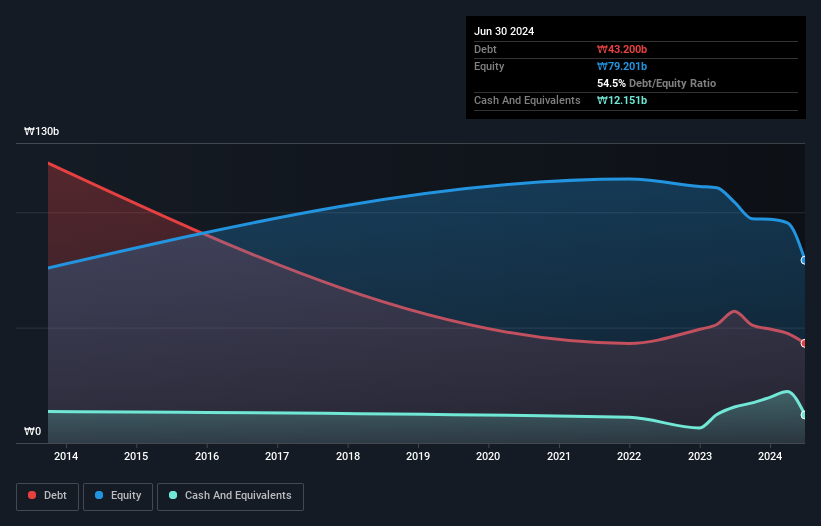- South Korea
- /
- Electronic Equipment and Components
- /
- KOSDAQ:A066900
DAP (KOSDAQ:066900) Has Debt But No Earnings; Should You Worry?
Warren Buffett famously said, 'Volatility is far from synonymous with risk.' So it seems the smart money knows that debt - which is usually involved in bankruptcies - is a very important factor, when you assess how risky a company is. We can see that DAP Corporation (KOSDAQ:066900) does use debt in its business. But the real question is whether this debt is making the company risky.
When Is Debt Dangerous?
Debt assists a business until the business has trouble paying it off, either with new capital or with free cash flow. Part and parcel of capitalism is the process of 'creative destruction' where failed businesses are mercilessly liquidated by their bankers. While that is not too common, we often do see indebted companies permanently diluting shareholders because lenders force them to raise capital at a distressed price. Of course, plenty of companies use debt to fund growth, without any negative consequences. When we think about a company's use of debt, we first look at cash and debt together.
See our latest analysis for DAP
How Much Debt Does DAP Carry?
The image below, which you can click on for greater detail, shows that DAP had debt of ₩43.2b at the end of June 2024, a reduction from ₩57.1b over a year. However, it also had ₩12.2b in cash, and so its net debt is ₩31.0b.

How Healthy Is DAP's Balance Sheet?
Zooming in on the latest balance sheet data, we can see that DAP had liabilities of ₩158.4b due within 12 months and liabilities of ₩105.4b due beyond that. Offsetting this, it had ₩12.2b in cash and ₩41.6b in receivables that were due within 12 months. So it has liabilities totalling ₩210.1b more than its cash and near-term receivables, combined.
This deficit casts a shadow over the ₩37.8b company, like a colossus towering over mere mortals. So we'd watch its balance sheet closely, without a doubt. After all, DAP would likely require a major re-capitalisation if it had to pay its creditors today. There's no doubt that we learn most about debt from the balance sheet. But you can't view debt in total isolation; since DAP will need earnings to service that debt. So if you're keen to discover more about its earnings, it might be worth checking out this graph of its long term earnings trend.
In the last year DAP wasn't profitable at an EBIT level, but managed to grow its revenue by 22%, to ₩447b. With any luck the company will be able to grow its way to profitability.
Caveat Emptor
Despite the top line growth, DAP still had an earnings before interest and tax (EBIT) loss over the last year. Indeed, it lost a very considerable ₩19b at the EBIT level. If you consider the significant liabilities mentioned above, we are extremely wary of this investment. That said, it is possible that the company will turn its fortunes around. But we think that is unlikely since it is low on liquid assets, and made a loss of ₩12b in the last year. So we think this stock is quite risky. We'd prefer to pass. There's no doubt that we learn most about debt from the balance sheet. But ultimately, every company can contain risks that exist outside of the balance sheet. To that end, you should be aware of the 1 warning sign we've spotted with DAP .
If you're interested in investing in businesses that can grow profits without the burden of debt, then check out this free list of growing businesses that have net cash on the balance sheet.
New: Manage All Your Stock Portfolios in One Place
We've created the ultimate portfolio companion for stock investors, and it's free.
• Connect an unlimited number of Portfolios and see your total in one currency
• Be alerted to new Warning Signs or Risks via email or mobile
• Track the Fair Value of your stocks
Have feedback on this article? Concerned about the content? Get in touch with us directly. Alternatively, email editorial-team (at) simplywallst.com.
This article by Simply Wall St is general in nature. We provide commentary based on historical data and analyst forecasts only using an unbiased methodology and our articles are not intended to be financial advice. It does not constitute a recommendation to buy or sell any stock, and does not take account of your objectives, or your financial situation. We aim to bring you long-term focused analysis driven by fundamental data. Note that our analysis may not factor in the latest price-sensitive company announcements or qualitative material. Simply Wall St has no position in any stocks mentioned.
About KOSDAQ:A066900
DAP
Engages in the provision of printed circuit boards (PCB) South Korea and internationally.
Low risk and slightly overvalued.
Market Insights
Weekly Picks


Crazy Undervalued 42 Baggers Silver Play (Active & Running Mine)


Fiducian: Compliance Clouds or Value Opportunity?

Willamette Valley Vineyards (WVVI): Not-So-Great Value
Recently Updated Narratives

TXT will see revenue grow 26% with a profit margin boost of almost 40%

Significantly undervalued gold explorer in Timmins, finally getting traction

Moderation and Stabilisation: HOLD: Fair Price based on a 4-year Cycle is $12.08
Popular Narratives


MicroVision will explode future revenue by 380.37% with a vision towards success


NVDA: Expanding AI Demand Will Drive Major Data Center Investments Through 2026





